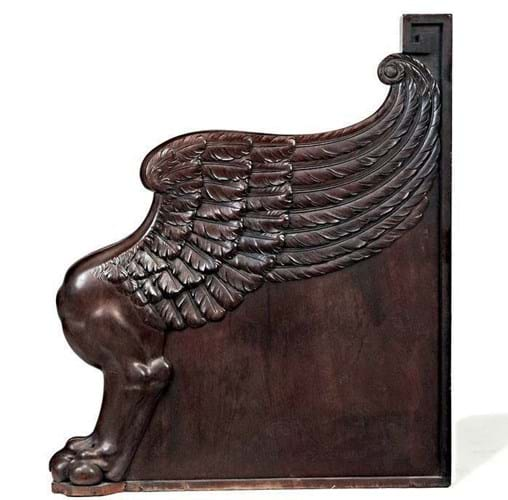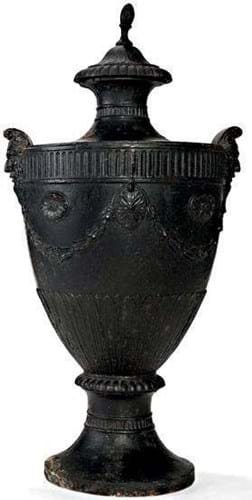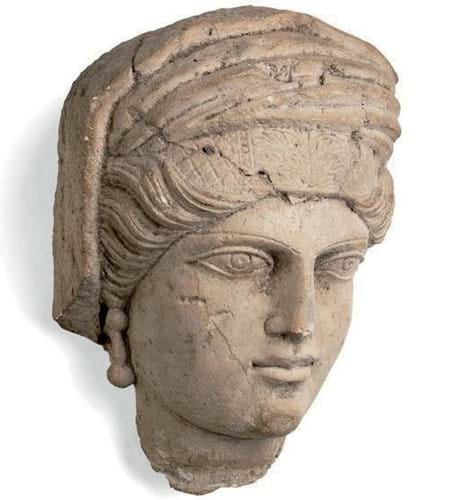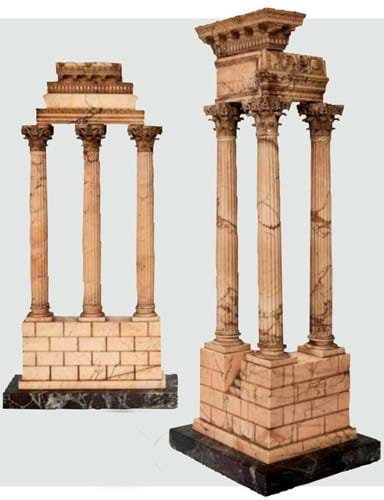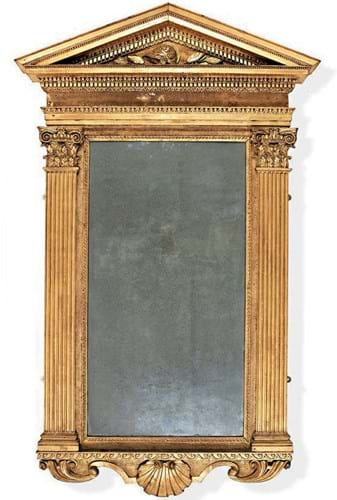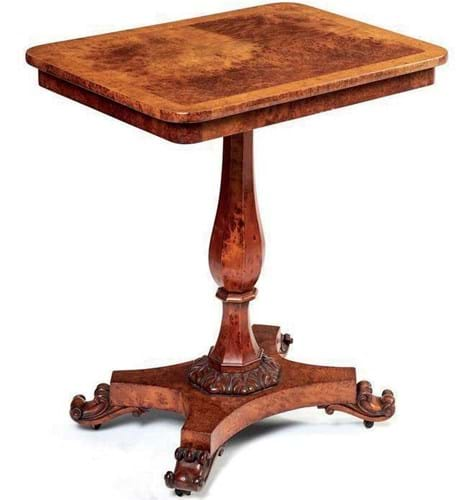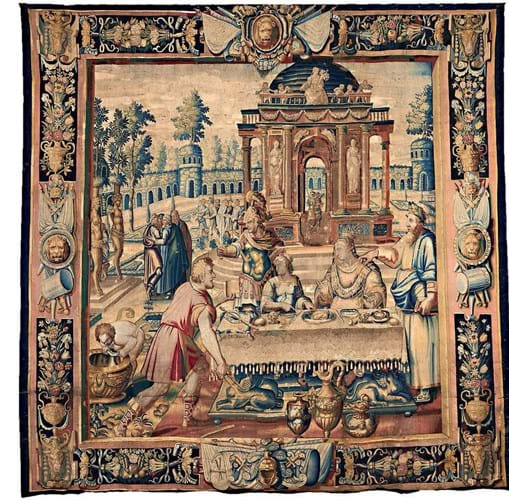
Among the last big acts of the regional auction scene in the days before the coronavirus lockdown was Dreweatts’ (25% buyer’s premium) sale of the private collection of the architect Sir William Whitfield (1920-2019).
The 570 lots, sold at Donnington Priory across two untroubled days on March 10-11, came to Newbury from St Helen Hall, a Palladian house in County Durham.
Whitfield – a designer of some memorable modern buildings sensitive to their historical context including Richmond House in Whitehall and the redeveloped Paternoster Square – had purchased the property in 1967 when it was at imminent risk of demolition.
Restored to its former glory over the course of four decades, it was furnished by Whitfield and his partner Andrew Lockwood in the English country house style with a decorative twist.
Interior design promotion
The consignment came to Dreweatts via valuation firm and parent company Gurr Johns. However, there was much work still to be done.
A busy saleroom and a £1.2m total owed thanks to some savvy cross-brand promotion that included a tie-up with interior design firm Colefax & Fowler, the redecoration of two viewing rooms in Farrow & Ball paint and a series of talks and ‘panel discussions’. All were perfect fodder for Instagram followers and achieved by head of sale Joe Robinson without incurring great cost.
Making purchases at auction and through the trade, Whitfield acquired some of the better pieces in the sale 50 years or more ago.
The financial highlight of the collection was a 17th century Flemish historical tapestry depicting The Triumph of Mark Anthony over the Parthians, pictured on the front page of ATG No 2434.
Made to a design by Dutch Golden Age painter Karel van Mander the Younger (1579-1623), it fits the description of a panel last sold at Sotheby’s in 1965. It took a multi-estimate £120,000.
Tapestry on the rise
There are renewed signs of life in the tapestry market – given the right combination of subject matter and condition. A Paris weaving of similar monumental scale, made in the second quarter of the 17th century at the Faubourg Saint-Marcel workshops, was probably that sold at Sotheby’s in 1966.
The subject, from a popular cycle depicting the life of the Anatolian queen Artemisia created by Northern Mannerist painter Antoine Caron (1521-99), is The Feast, or Artemisia Instructing her Architect.
The border of lion’s masks, trophies and flowering vases (one of several designs recorded for this series) includes the weaver’s mark FVP for François de la Planche (1573-1627).
It too generated good competition against a modest starting point and sold at £27,000.
Bulletti panels

One of a pair of carved and bronzed architectural wood panels by Anton Leone Bulletti – £18,000 at Dreweatts.
Displayed in the drawing room in St Helen Hall were eight carved bronzed wood panels in the baroque taste, each a riot of satyrs, fruiting vines and grotesque masks.
They are probably by Anton Leone Bulletti (b.1824), the Tuscan woodcarver who spent much of his working life in England, first at Alnwick Castle under the patronage of the fourth Duke of Northumberland, then in Newcastle as a carver and draftsman at High Bridge and Grey Street (1860-78) and latterly as a senior instructor at the School of Art Wood-Carving in London. (Rosamond Allwood’s article The Eminent Italian Artist, Signor Bulletti is the best source of information on the subject.)
These panels, some dated 1864, are thought to be part of the architectural woodwork supplied by Bulletti to Lartington Hall in Teesdale. His patron was Thomas Whitham (d.1897), the fourth son of an influential Catholic family whose extravagant lifestyle was said to be unpopular with Rome – as was his request to be laicised in the hope of perpetuating the Witham line.
The panels probably left the property when it was sold in 1911. Andrew Lockwood recalled: “It was only when a photo of a lost interior appeared in Country Life were we able to establish that the panels had come from Lartington Hall. The connection was then made to Bulletti with the designs included in one of his sketch books held at the V&A.”
Offered as four pairs, they took prices of between £9500-18,000, largely dependent on condition.
Bulletti works rarely appear for sale. However, by way of some sort of comparison, is a much smaller 11in (27cm) ‘Victoria Queen & Emperor’ panel sold for £2100 at Anderson & Garland in Newcastle in June 2019. Carved as a tied bouquet of roses, thistles, shamrocks and the lily of India it was titled, signed and dated November 1, 1876.
Superb carving
Another of Whitfield’s ‘discoveries’ had been a pair of superbly carved Regency ebony sofa ends boldly worked in the form of winged monopodiae in the manner of Thomas Hope (1769-1831).
The discernible shadow of now-lost corner mounts of scrolling anthemion and Greek key suggests they are indeed those supplied by the enigmatic ‘Mr Bogaert’ for ‘The Vase Room’ at Hope’s London home on Duchess Street. The seat, bordering three walls of a room where Hope displayed his vast collection of Greek figured vases, is well known from a plate in Household Furniture and Interior Decoration (1807).
It was later removed to Deepdene in Surrey and sold as lot 1059 at a famous sale in 1917. Whitefield found them in a ‘junk shop’ in the 1960s and subsequently converted them to a sofa upholstered in blue silk and gold brocade. Estimated at £8000- 12,000, it sold at £26,000.
A pair of George III cast-iron stoves modelled as (1.05m) neoclassical urns after Robert Adam c.1780 sold at £6200.
Probably made at the Carron Company (the model is closely related to a late 18th century pen and ink drawing of a ‘pedestal stove’ found in the foundry’s papers at the Scottish Record Office), others are known at Temple Newsam, Leeds and Compton Place, Sussex.
Funerary fragments
A keen collector from a young age, Whitfield is thought to have acquired five ancient funerary busts in Newcastle in the early 1940s.
Dating from the early 3rd century, these fragments blending the Greco- Roman and Parthian traditions are typical of those found in Palmyra, in present-day, war-torn Syria. All surpassed modest estimates with the most commercial of the group, a 10in (25cm) high head of a woman wearing an elaborately carved diadem, selling at £11,000.
Marble renditions of Roman monuments were popular souvenirs for Grand Tourists visiting the Eternal City during the later 18th and 19th centuries – the temples of Castor and Pollux and Vespasian among the most reproduced.
The pair here were unusually large, standing up to 2ft 4in (72cm) high on rosso antico plinths, and superior in terms of execution. Sets of similar scale dating to the second quarter of the 19th century have been sold in London and New York including those offered at Christie’s New York in April 2019 sold at $20,000. The Whitfield pair, pitched at £5000-8000, took £21,000.
The St Helen Hall furniture often scored its highest marks for style and good looks rather than original condition. However, decent competition emerged for a pair of George III serpentine card sycamore and harewood tables, c.1790, with tulipwood crossbanded tops and medallions of butterflies and urns. With a provenance to Castle Hyde, County Cork, they sold at £14,000.
An Irish carved and gilt-gesso pier mirror in the Palladian style with a pediment centred by a Roman helmet and pilasters above Vitruvian scrolls and shells, sold at £17,500.
Possibly made by the ‘looking glass merchants’ John and Francis Booker of Dublin, a provenance connected it to Castletown House, built in 1722 for William Conolly, the Speaker of the Irish House of Commons. It had been bought by Whitfield in London in the 1960s.
Unusual timbers
There was also good interest in a number of 19th century pieces made in unusual timbers – particularly the burr veneers that Lockwood said were favourite. The totara knot and hinan woods to an occasional table c.1845 gave a clue to its exotic origins.
A label to the underside reads This wood imported from Wellington, New Zealand and manufactured GDM Levene, New Zealand House, London.
Born in Prussia where he took his cabinet-making apprenticeship, Johan Marti Levien (1811-71) is today best known for his associations with New Zealand where he worked for a handful of years in the early 1840s and later used to supply exotic timbers to his London workshop.
His clients included Queen Victoria, from whom he received a royal appointment, and Baron of Rothschild, who requested an entire room made of totara and hinau.
This table was estimated at £1500-2000 but sold to a buyer via thesaleroom.com at £12,000. A similar table in totara knot, this time without a label to identify its maker, made £3500.


